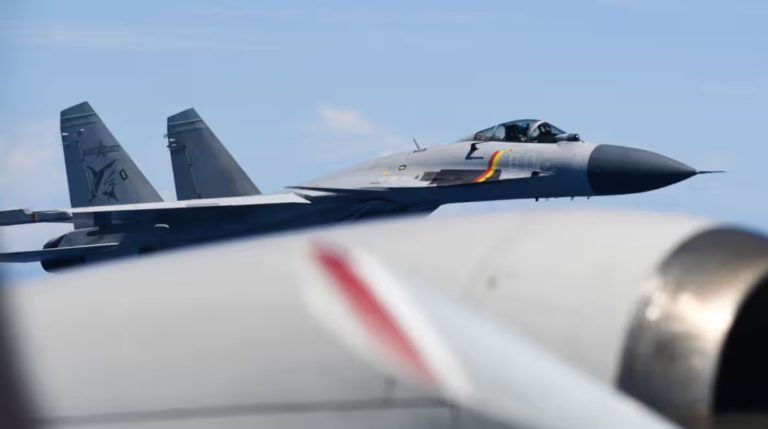Japan has raised strong concerns after a close encounter between one of its patrol aircraft and a Chinese fighter jet over the Pacific Ocean, amid rising regional tensions linked to China’s growing military activity.
The incident occurred when a Chinese J-15 fighter jet took off from the aircraft carrier Shandong and flew within approximately 45 meters of a Japanese Self-Defense Force (SDF) plane. Japan’s Chief Cabinet Secretary, Yoshimasa Hayashi, called the incident dangerous and urged China to take steps to prevent any future recurrence. The near miss happened over international waters last weekend.
According to Japan’s defense ministry, the Chinese jet also carried out other risky maneuvers, including flying directly in front of an SDF aircraft at the same altitude and just 900 meters apart. While there were no reported injuries or damage, Japanese officials labeled the approaches “abnormal” and “dangerous,” noting that they could have easily resulted in a collision.
The encounter has deepened regional concerns about China’s increasingly assertive military behavior, particularly its use of naval and air power to project influence in the Asia-Pacific. Beijing has frequently sent warships, coast guard vessels, and aircraft near contested areas, especially around disputed islands in the East China Sea. But recent operations suggest an effort to expand its reach much farther into the Pacific.
China has not officially responded to Japan’s protest over the incident. However, earlier this week, the Chinese foreign ministry defended the dual aircraft carrier exercises that included the Shandong and Liaoning, urging Japan to respond “objectively and rationally.” A ministry spokesperson stated that Chinese naval operations in the region are fully in line with international law and norms, emphasizing that China’s defense strategy remains strictly defensive.
Chinese officials said the drills, involving both carriers, were intended to assess the military’s ability to conduct long-range operations and joint missions at sea. The exercises marked the first known instance of a Chinese aircraft carrier operating east of the so-called “second island chain” — a strategic boundary that includes Guam and reflects an expansion of China’s naval ambition beyond its traditional operating zones.
The first island chain encompasses Japan, Taiwan, and parts of the Philippines. Extending beyond it to the second chain signals China’s intention to build blue-water naval capability and operate further from its mainland shores. Japan’s defense minister, Gen Nakatani, said China appears determined to enhance the operational capacity of its aircraft carriers and improve its reach into distant maritime and aerial zones.
Incidents involving risky maneuvers by Chinese fighter pilots are not new. Countries including Australia, the Philippines, the United States, and Canada have all reported dangerous interactions with Chinese military aircraft as recently as February.
That same month, the People’s Liberation Army conducted live-fire naval exercises in the Tasman Sea between Australia and New Zealand. Though Chinese officials insist such operations are not aimed at any specific country, the PLA has made no secret of its preparations to gain the capability to carry out a potential invasion of Taiwan.
Tensions have also been heightened by Chinese state media, which recently accused Japan of undermining its pacifist postwar constitution. Reports criticized Japan’s planned missile deployment to Kyushu — the southernmost of its main islands — as provocative, arguing such moves threaten regional stability.
Meanwhile, both the Shandong and Liaoning entered Japan’s exclusive economic zone (EEZ) for the first time over the weekend. The Shandong sailed through waters around 550 kilometers southeast of Miyako Island in Okinawa Prefecture, conducting fighter jet and helicopter drills north of Okinotori Island, Japan’s southernmost point.
On the same day, the Liaoning was spotted 300 kilometers southwest of Minamitori Island before leaving Japan’s EEZ and performing similar exercises, according to Kyodo News.
These developments underscore the mounting pressure in the region as China continues to test the boundaries of its military presence and neighboring countries brace for the implications of its expanding reach.

